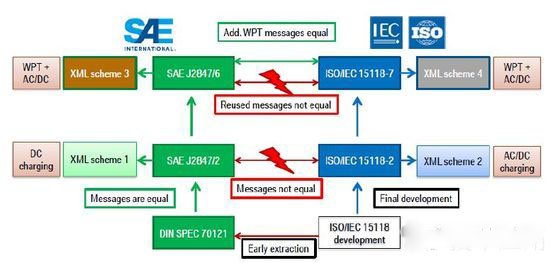I couldn't help but laugh when I read the report of Mr. Daniel Mikat of Toyota in the June meeting of IWC. However, I think that the chapter of China's electric vehicles entering wireless charging has to rely on ZTE's leadership, and can't laugh.
As shown in the figure below, the hardware part of the wireless charging is mainly on the car and under the car. The car is laid by the operator/service provider, and the car is laid by our car engineers.

In order to run this system safely and orderly, the basic coordination work needs to be coordinated between the wireless charging pile and the vehicle. According to Toyota, this piece needs to have a minimum interoperability requirement.
1) Communication (SAE J2847/6, ISO/IEC 15118-7)
SAE is generally a private standards body led by American and Japanese car manufacturers, and there is a dispute with the ISO/IEC European car factory. Fortunately, SAE is generally faster. There are many people voting in ISO/IEC. It is slower and has something to talk about.

2) EMC/EMI requirements (Incl. FCC Part 18)
In the FCC standard, the non-ISM band, 15&TImes; SQRT (power/500) is defined, and the initial test water of 3.3 KW is acceptable. The latter 6.6 or even larger is yet to be defined.
3) Radiation exposure (ICNRP2010) and medical device exposure limits
The wireless charging magnetic field will still come out. Here I still need to do more homework to see how the body responds after the big one. I am very curious to come to play a bus bus, when charging, is it necessary for everyone to get off or run a few tens of meters.

4) Improve the performance of charging
– single frequency (85kHz)
– define minimum efficiency
– Define the alignment accuracy (X, Y, Z), especially the Z direction directly determines the efficiency
– The depot defines the largest installation size
– Define the parking space installation location
– Anti-interference ability (TPMS, PEPS, FOB)
Walking in front is hard work, Toyota is quite powerful.
Summary :
1) GB has been established, how to play this stuff?
2) After conducting the standard of conduction, is it going to continue to close the door? I think if this wireless charging really does, the problem of security risks and utilization is not small.
3) Due to the communication industry, after our domestic propaganda, it is too myth to refer to the standard to the first-class enterprise. You can do it, but you can use it, at least send more engineers, and prepare some funds to do some Experiment, it is appropriate to speak according to the data
Plano Concave Cylindrical Lens
Plano concave Cylindrical Lens has one inward surface and one flat surface.
Cylindrical lenses are typically applied to focus incoming light to a line, or to change the aspect ratio of an image. they are used for the optics, lasers, medical science, electronics, tele-communication and others.
Realpoo Optics can offer cylindrical Lenses include convex cylindrical lens, concave cylindrical lens, meniscus cylindrical lens, and doublet achromatic cylindrical lens ect.Specifications:
Material : N-BK7, N-SF1 , Fused Silica , N-SF10 etc
Diameter : 2mm ~ 300mm
Focal Legnth Tolerance :+/-1%
Diameter Tolerance :+0.0/-0.1mm
Thickness Tolerance :+/-0.1mm
Surface Quality :40/20 or better
Centration :<3 arc minutes
Clear Aperture :>90%
Bevel : Protective bevel as needed
Coating :Upon your request
Plano Concave Cylindrical Lens,Laser Line Generator,Laser Line Lens,Cylindrical Lenses
Changchun Realpoo Photoelectric Co., Ltd. , https://www.optics-realpoo.com
